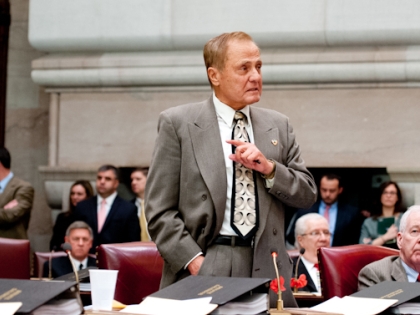
Senate’s Joint Task Force on Heroin and Opioid Addiction Releases Report and Legislative Recommendations
John J. Bonacic
June 5, 2014
-
ISSUE:
- Controlled Substances
The New York State Senate Joint Task Force on Heroin and Opioid Addiction today released a report summarizing the findings of statewide forums held to examine the issues surrounding the increase in drug abuse, addiction and drug related crimes in New York. The report includes a comprehensive package of bills recommended for action this legislative session that target prevention, treatment, and enforcement issues raised during extensive testimony provided by dozens of experts, parents, and concerned New Yorkers.
In March 2014, New York State Senate Majority Coalition Co-Leaders Dean Skelos and Jeffrey Klein created the Joint Task Force on Heroin and Opioid Addiction to examine the alarming rise in use of heroin and opioids that has claimed lives and hurt families across New York State.
The task force is chaired by Senator Phil Boyle (R-C-I, Suffolk County), Chairman of the Senate Committee on Alcoholism and Drug Abuse. Members include Vice-Chair David Carlucci (D-Rockland), Chairman of the Senate Committee on Mental Health and Developmental Disabilities; Vice-Chair Michael Nozzolio (R-C, Fayette), Chairman of the Senate Codes Committee; Senator Greg Ball (R-C-I, Patterson), Senator John Bonacic (R-C-I, Mount Hope), Senator Simcha Felder (D-Brooklyn), Senator Pat Gallivan (R-C-I, Elma), Senator Martin J. Golden (R-C-I, Brooklyn), Senator Joseph A. Griffo (R, Rome), Senator Kemp Hannon (R, Nassau), Senator Andrew Lanza (R-I-C, Staten Island), Senator William Larkin (R-C, Cornwall), Senator Betty Little (R-C-I, Queensbury), Senator Carl L. Marcellino (R, Syosset), Senator Kathleen A. Marchione (R-C, Halfmoon), Senator Jack Martins (R-C-I, Mineola), Senator George Maziarz (R-C, Newfane), Senator Thomas O’Mara (R-C, Big Flats), Senator Michael Ranzenhofer (R-C-I, Amherst), Senator Patty Ritchie (R-C, Heuvelton), Senator Joseph Robach (R-C-I, Rochester), Senator Diane Savino (D, Staten Island/Brooklyn), Senator James L. Seward (R-I-C, Oneonta), Senator David J. Valesky (D-Oneida), and Senator Cathy Young (R-I-C, Olean).
Senator Boyle said, “The current heroin and opioid epidemic has touched untold lives and brought immeasurable suffering to New Yorkers. The proposals our Heroin Task Force bring forward today mark the most significant efforts ever undertaken to combat an addiction crisis in our state. I can promise you one thing - the report we issue today, along with 25 separate pieces of legislation the state Senate will pass in the coming weeks, will save countless lives.”
Over the past nine weeks, task force members held 18 forums throughout New York including in Cayuga, Chautauqua, Chemung, Clinton, Genesee, Jefferson, Monroe, Nassau, New York, Oneida, Orange, Otsego, Putnam, Rensselaer, Richmond, Rockland, Suffolk and Sullivan counties. Task force members traveled over 8,000 miles, spoke with more than 200 panelists, and listened to over 50 hours of testimony. Forum participants examined the issues surrounding the increase in drug abuse, addiction and drug related crimes, solicited input from experts and other stakeholders, and developed recommendations that were used to create a comprehensive package of legislation to address these issues.
Parents told harrowing stories about loved ones addicted to opioids and the difficulty in receiving critical treatment. Law enforcement officials testified that they needed stronger tools to prevent criminals from putting more deadly drugs on the streets. Treatment and medical professionals urged lawmakers to treat opioid addiction as a disease, and to make treatment more readily and widely available. Prevention groups and educators focused on eliminating the stigma associated with addiction and supported the creation of more programs to inform the public about the dangers of substance abuse. Recovering addicts advocated for more treatment options, more beds, and more recovery time.
Dr. Jeffrey Reynolds, Executive Director of the Long Island Council on Alcohol and Drug Dependence, said, “As Long Island and all of New York State struggles under the weight of a continuing opiate crisis, I’m heartened by the work of the Senate Task Force and elated to see such a well-rounded package of proposals designed to enhance access to substance abuse prevention, addiction treatment and recovery support services. I’m particularly proud of the fact that Long Island’s own Senator Phil Boyle chaired the Task Force, traveled across New York gathering community input, and is leading the effort to make policy changes that will reduce barriers to care and strengthen our state’s approach to addiction.”
Sullivan County Sheriff Michael A. Schiff said, “I am pleased to see that the New York Senate is taking a comprehensive approach to a very complex issue. We cannot simply arrest our way out of this problem. We must attack it at several levels including education and treatment.”
Testimony at the forums directed the task force’s legislative response to three key areas: preventing drug abuse and overdoses; increasing the availability and efficacy of addiction treatment; and enhancing the tools provided to law enforcement to keep heroin off the streets. As a result, the task force is recommending the following 25 bills for the Senate to consider during the 2014 legislative session:
Preventing Opioid Abuse and Overdoses
· Preventing opioid overdoses in schools (S7661, Hannon): Clarifies that school districts, Board of Cooperative Educational Services (BOCES) programs, charter schools, and other educational entities may possess and administer naloxone to treat opioid overdoses, and will be protected by Good Samaritan laws.
· Increasing the effectiveness of overdose prevention (S7649, Marchione): Provides that naloxone kits distributed through an opioid overdose prevention program must include an informational card with instructions on steps to take following administration, as well as information on how to access addiction treatment and support services. Opioid overdose prevention programs provide those at risk of an overdose, their family members and their friends with naloxone kits and training on proper administration.
· Limiting prescriptions for acute pain (S2949A, Hannon): Limits the number of Schedule II and III controlled substances prescribed for acute pain to a 10-day supply to prevent excess pharmaceuticals from being dispensed, and therefore reduce the risk of diversion. This restriction would not apply to the treatment of cancer pain, chronic pain or palliative care. Further, the bill provides that only one co-payment may be charged for a 30-day supply.
· Increasing public awareness (S7654, Boyle): Requires the Office of Alcoholism and Substance Abuse Services (OASAS) and the Department of Health (DOH) to establish the Heroin and Prescription Opioid Pain Medication Addiction Awareness and Education Program. The program would utilize social and mass media to reduce the stigma associated with drug addiction, while increasing public’s knowledge about the dangers of opioid and heroin abuse, the signs of addiction, and relevant programs and resources.
· Establishing school drug prevention programs (S7653, Martins): Adds age-appropriate information about the dangers of illegal drug use to junior high school and high school health class curriculums.
· Promoting pharmaceutical take-back events (S6691, Boyle): Requires OASAS to post guidelines and requirements for conducting a pharmaceutical collection event on its website. According to the Substance Abuse and Mental Health Service Administration (SAMHSA), nearly 70 percent of those who first abuse prescription drugs get the pills from a friend or relative. Facilitating proper and timely disposal of unused narcotics helps to reduce the danger of diversion.
· Ensuring prescribing practitioners stay abreast of best practices (S7660, Hannon and Maziarz): Creates a continuing medical education program for practitioners with prescribing privileges. DOH and the State Education Department (SED) would establish standards for three hours of biennial instruction on topics including Internet System for Tracking Over-Prescribing (I-STOP) requirements, pain management, appropriate prescribing, acute pain management, palliative medicine, addiction screening and treatment, and end-of-life care.
Increasing the Availability and Efficacy of Addiction Treatment
· Creating a new model of detoxification and transitional services (S2948, Hannon): Establishes the Opioid Treatment and Hospital Diversion Demonstration Program, requiring the development of a new model of detoxification and transitional services for individuals seeking to recover from opioid addiction that reduces reliance on emergency room services.
· Establishing a relapse prevention demonstration program (S7650, Carlucci): Creates a Wraparound Services Demonstration Program through which OASAS would provide case management or referral services for nine months to individuals who successfully complete substance abuse treatment programs. These community supports - access to which is intended to prevent a relapse - include educational resources, peer-to-peer support groups, social services and family services and counseling, employment support and counseling transportation assistance, medical services, legal services, financial services, and child care services.
· Enabling parents to require children to undergo treatment (S7652, Martins): Provides that a parent or guardian may petition to have a minor child designated as a Person in Need of Supervision (PINS) due to a substance use disorder, and that a court may require a PINS child to undergo substance abuse treatment.
· Establishing assisted outpatient treatment for substance use disorders (S7651, Carlucci): Enables a court to order Assisted Outpatient Treatment (AOT) for an individual with a substance use disorder who, due to his or her addiction, poses a threat to him or herself or others.
· Promoting the affordability of substance abuse services (S7662, Seward, Hannon, Martins and Ritchie): Improves the utilization review process for determining insurance coverage for substance abuse treatment disorders, and requires insurers to continue to provide coverage throughout the appeals process.
Providing Additional Resources to Law Enforcement
· Studying the conversion of correctional facilities to treatment centers (S7655A, Boyle and Nozzolio): Directs OASAS and the Department of Corrections and Community Supervision (DOCCS) to study the feasibility of converting closed correctional facilities to provide treatment for substance use disorders. Agencies would examine the feasibility of such centers providing both inpatient residential and outpatient care.
· Establishing the crime of homicide by sale of an opioid controlled substance (S7657, Robach): Creates an A-I felony for the unlawful transportation or sale of an opioid that causes the death of another.
· Restricting drug dealers from participating in the SHOCK incarnation program (S7656, Nozzolio): Holds drug dealers accountable by preventing participation in the SHOCK incarceration program – under which young adults receive substance abuse treatment, academic education, and other services to promote reintegration – by individuals convicted of a A-II felony drug offense, except if he or she tests positive for a controlled substance upon arraignment.
· Improving safety at judicial diversion programs (S1879, Bonacic): Requires a court, in determining a defendant's eligibility for a judicial diversion program for alcohol or substance abuse treatment, to consider the underlying charges and the defendant's propensity for violent conduct. The bill also requires the facility treating a defendant under this diversion program to notify the local law enforcement of the defendant's placement and arrest record, and to submit a security plan to the Division of Criminal Justice Services (DCJS) to provide for the safety of staff, residents and the community. Finally, this bill allows a defendant to appear via video conference, and makes unauthorized departure from a rehabilitation facility a D felony.
· Reallocating funds from asset forfeitures (S7658, Nozzolio): Reduces the state share of certain asset forfeitures to increase allocations for the reimbursement of expenses incurred by localities for investigation and prosecution, and provides additional monies for the Chemical Dependence Service Fund.
· Creating Drug-Free Zones around treatment facilities (S1388, Skelos): Establishes a B felony for the sale of a controlled substance within 1,000 feet of a drug or alcohol treatment center or methadone clinic.
· Expanding the crime of operating as a major trafficker (S7663, Nozzolio): Facilitates convictions for operating as a major trafficker by reducing the number of people that must have participated from four to three, and lowering the minimum required proceeds from the sale of controlled substances during a 12-month period from $75,000 to $25,000.
· Establishing the crime of transporting an opioid controlled substance (S7659, Boyle): Allows prosecution for a new crime when an individual unlawfully transports an opioid any distance greater than five miles within the state, or from one county to another county within the state, to address diversion and distribution of heroin and prescription drugs.
· Facilitating the conviction of drug dealers (S7169, Boyle): Provides that possession of 50 or more packages of a Schedule I opium derivative, or possession of $300 or more worth of such drugs, is presumptive evidence of a person’s intent to sell.
· Preventing illegal drug sales by doctors and pharmacists (S2941, Hannon): Provides for an enhanced penalty – a B felony – for practitioners and pharmacists who abuse the standards of their respective profession and violate the public trust by illegally selling controlled substances.
· Establishing criminal penalties for the theft of blank official New York State prescription forms (S2940, Hannon): Expands grand larceny in the fourth degree to include the theft of a blank official New York State prescription form. This bill would also redefine criminal possession of stolen property in the fourth degree to include the possession of a stolen New York State prescription form, and create an A misdemeanor of criminal possession of a prescription form.
· Increasing the penalties for theft of controlled substances (S2431, Klein, Passed Senate 3/24/2014): Provides enhanced penalties for the theft of controlled substances, treating such crimes similarly to a theft of firearms, credit or debit cards, scientific secrets, or certain methamphetamine precursors.
· Prosecuting acts by street gangs (S4444A, Golden): Creates the Criminal Street Gang Enforcement and Prevention Act to provide a comprehensive approach to protecting the public from gang-related crimes and violence, including those that relate to drug trafficking, and establishing the criminal street gang prevention fund.
The full report can be viewed online at www.nysenate.gov.
The report also highlights other recent legislative actions to protect the well-being of people suffering from the drug addiction. In 2012, the state enacted a law sponsored by Senator Lanza and Senator Hannon to create the successful Internet System for Tracking Over-Prescribing (I-STOP) Act (S7637), which created a real-time database for healthcare practitioners to consult prior to prescribing potentially addictive medicines such as oxycodone and hydrocodone.
Earlier this year, the Senate passed a bill sponsored by Senator Hannon (S6477B) to allow authorized health care professionals to increase public access to Narcan/naloxone. Also, the Fiscal Year 2015 enacted budget included $3.3 million in funding to support substance abuse services.
Task Force Vice-Chair Senator David Carlucci (D-Rockland) said: “We can no longer ignore the fact that there exists a frightening heroin epidemic that is plaguing our communities and putting our children at risk. Heroin does not discriminate and sadly affects too many New Yorkers irrespective of all backgrounds. This legislative package and recommendations will save lives.”
Task Force Vice-Chair Senator Michael Nozzolio (R-C, Fayette) said: “The Task Force learned that the heroin crisis is an epidemic and is no longer contained to just inner big cities, but is having a horrendous impact on our suburbs, small cities and rural areas. Our focus is on providing additional resources for prevention and the treatment of those addicted, while strengthening criminal justice laws to prosecute criminals who are spreading heroin in our local communities.”
Senator Greg Ball (R-C-I, Patterson) said: “As legislators, we must do everything in our power to protect our children from drug addiction. We must require insurance companies to provide proper coverage for those addicted and we must enable family members to get their loved ones into treatment. I am eager to work with my colleagues in a bipartisan way to combat this epidemic.”
Senator John Bonacic (R-C-I, Mount Hope) said: “I thank our panelists who joined us at the Sullivan County Government Center, which I hosted on May 9. Their experiences, comments, suggestions and personal stories have been taken into careful consideration as our Senate Task Force colleagues and I put forth legislation to try to combat this epidemic. Government has to step up and do everything possible to fight back against this heroin problem, but we will still need the entire community to help us. Heroin addiction affects everyone: youth and adults alike. It transcends regions, race, gender and economic status, and only by learning from these informed professionals can we begin to address this crisis. We must do everything in our power to help stop this highly accessible and addictive drug from poisoning our residents.”
Senator Simcha Felder (D-Brooklyn) said: “Heroin and opioid addiction does not discriminate across racial, ethnic, or socio-economic lines. An addict in the throes of an addiction destroys not only their health and their futures, but the lives of their family and friends as well. For every addict who doesn’t get the help they need, there is a progressive breakdown in the fabric of society-at-large. I am proud to be part of the Senate Joint Task Force on Heroin and Opioid Addiction charged with tackling this devastating disease. Together with my colleagues and input from experts and concerned New Yorkers, I am hopeful we can reverse the tide on this issue.”
Senator Pat Gallivan (R-C-I, Elma) said: “As a former state trooper and Sheriff of Erie County, I have seen firsthand the devastating impact that drugs and drug addiction can have on our communities. As heroin use and opioid addiction continues to rise, New Yorkers are demanding action. This package of legislation gives law enforcement the tools they need to go after the criminals who sell drugs on our streets, makes drug treatment more widely available, and provides programs to better inform the public about the danger of opioid addiction.”
Senator Martin J. Golden (R-C-I, Brooklyn) said: “I am so proud of the work that this State Senate Task Force was able to achieve and the recommendations we have made. There is no doubt in my mind that prescription drug abuse, and heroin overdoses, are among the most significant problems of our time facing New York. We have lost too many lives and we cannot, and will not, let this epidemic continue to destroy families. I commend Chairman Phil Boyle and my colleagues for taking on this monumental task so successfully. I am also grateful that working with this task force, we have recognized the need to increase the penalties against gang violence in an effort to curb this drug problem.”
Senator Joseph A. Griffo (R, Rome) said: “Our task force has put together a comprehensive package that addresses many of the problems I heard about from addiction treatment and law enforcement experts during the forum I hosted. These bills would stop addiction before it starts by better educating the public, especially teenagers, about the risks of heroin; preventing overdoses by arming people with naloxone; making the treatment more affordable and available when needed; and helping us get tough on dealers and traffickers. We’ve had great success in curbing prescription abuse through the I-STOP program. It’s my hope that this legislation will stem the flow of heroin and other opioids through the Empire State.”
Senator Kemp Hannon (R, Nassau) said: “Every day we hear more stories of lives tragically being adversely affected by heroin use and abuse. Young, old, rich and poor alike are all feeling the effects of heroin, and the Task Force continues to gather information to help us address this crisis. Throughout our hearings across every corner of the state, we’ve heard from New Yorkers on how they’ve been impacted, and this has helped to guide us and prepare our legislation to combat this scourge.”
Senator Andrew Lanza (R-I-C, Staten Island) said: “Heroin and opioids are crippling, highly-addictive drugs that are causing overdoses and deaths in all corners of the state. By bringing together area stakeholders at regional forums across New York we gained a better understanding of this mushrooming crisis and have crafted legislation and policies to address this state-wide medical emergency. I thank Leader Dean Skelos and Task Force Chairman Phil Boyle for their leadership on this life and death issue.”
Senator Bill Larkin (R-C, Cornwall-on-Hudson) said: “Throughout this process it has become painfully clear that heroin and other opiates are quickly taking over our state. There isn’t one segment of society that hasn’t been impacted by these dangerous, addictive drugs. We have listened to families, healthcare providers, law enforcement officials and emergency responders and everyone has a compelling story that demonstrates we need to change the way we think about these drugs and how we deal with their presence in our communities.”
Senator Betty Little (R-C-I, Queensbury) said: “Heroin and opioid addiction will continue to worsen absent a comprehensive strategy and adequate funding to combat this growing crisis. With several weeks remaining in session, we have sufficient time to move forward on this package of bills that will help combat the problem and give hope to addicts and their loved ones. A great deal of credit goes to our task force chair, Senator Phil Boyle, and the many dozens of presenters, including those in Plattsburgh, who made time to share their perspectives and offer compelling viewpoints.”
Senator Carl L. Marcellino (R, Syosset) said: “The heroin epidemic has had a devastating effect all across New York State. Far too many lives have been destroyed by this powerfully addictive drug. This Task Force has worked diligently to hear from experts in addiction, treatment and law enforcement on how we can combat this seemingly out of control attack on the public health. I am proud to support this comprehensive legislative package and look forward to its passage.”
Senator Kathleen A. Marchione (R-C, Halfmoon) said: “Our report represents months of hard work in hearing and learning from recognized experts in the fields of law enforcement, addiction recovery and treatment, educators, health care and, most important, families who tragically lost a loved one to heroin and opioid addiction. The successful community forum I hosted at Hudson Valley Community College confirmed the fact that heroin abuse is a major challenge for our Capital Region. The fire of heroin and opioid addiction is still raging across New York, but this report – and our specific, community-based solutions to combat the abuse of these dangerous drugs – is the first step toward extinguishing that fire and saving lives. This report cannot be the final word though. We need positive, proactive, bi-partisan policies enacted this session that will help save lives. I want to acknowledge and thank our Task Force Chair, my colleague Senator Phil Boyle, for the tremendous leadership, advocacy and interest he has shown in directing our Task Force and keeping the focus solely on public policy solutions and saving lives, not politics.”
Senator Jack Martins (R-C-I, Mineola) said: “Every single community in New York State has been affected by the growing heroin epidemic. Continuing the status quo is not an option; more must be done to save lives and prevent tragedies. Improving treatment options, strengthening law enforcement's ability to get drug dealers off the streets, and increasing awareness and education about the dangers of heroin and opioids is a comprehensive approach to reversing the terrible damage these substances are causing in each and every one of our communities.”
Senator George Maziarz (R-C, Newfane) said: “The Heroin Task Force has been extremely active in holding hearings around the state, meeting with experts, and formulating sound reforms to address today’s heroin problem. This has been an intensive process and there is no doubt that it is moving our state in the right direction.”
Senator Thomas O’Mara (R-C, Big Flats) said: “I appreciate everyone on the front lines locally who helped us zero in on the heroin crisis. Their firsthand experience and their input is extremely valuable. We’re going to keep working to determine the most effective combination of law enforcement, awareness and education, and treatment and prevention to try to stop the spread of heroin, better protect our communities and save lives.”
Senator Michael Ranzenhofer (R-C-I, Amherst) said: “Heroin and opioid addiction is a very serious issue facing communities all across the state. This legislative package will help to combat the rise in heroin and opioid addiction and its negative effects on our communities. I commend Senator Boyle for taking the lead on this issue.”
Senator Patty Ritchie (R-C, Heuvelton) said: “In the North Country and Central New York regions, there’s been a dramatic increase in the use of heroin and related drugs. But, it’s not just here—it’s a problem that is affecting all of New York State and our entire nation. This task force and the forums we have hosted have given us an opportunity not only to get an inside look at addiction, but also, to learn from experts and those who have had direct experience with heroin and similar drugs about what can be done to step up prevention efforts, treat dependence and fight back against drug abuse and its related crimes.”
Senator Joseph Robach (R-C-I, Rochester) said: “Having sat on multiple public forums and panels for the Joint Senate Task Force on Heroin and Opioid Addiction, we heard firsthand from many drug addiction professionals and family members of addicts who testified about the dangers of heroin and opioid usage. This is a growing epidemic statewide that knows no boundaries and does not discriminate against gender, race or economic status. This proposed legislation will help put an end to this problem and help better educate the public about the risks of heroin and opioid usage.”
Senator Diane Savino (D, Staten Island/Brooklyn) said: “I want to personally thank Senator Boyle and his staff for having and correctly identifying Richmond County, Staten Island, as ground zero for this heroin and opioid epidemic. Eighteen hearings were held across New York State to get ideas and information from doctors, treatment experts, etc; however none were more emotionally raw than in Staten Island where we heard directly from the victims and their families, including the parents of John Crupi and James Hart who had just recently passed from overdoses to heroin. It is my hope this task force and its report will lead to action that will prevent deaths like the ones we have endured on Staten Island and across the state.”
Senator James L. Seward (R-I-C, Oneonta) said: “The heroin task force forums gave rise to tangible evidence underscoring the dangers and depth of this epidemic we are fighting. The expert testimony and tragic real-life stories opened eyes across the state, and are at the core of this comprehensive legislative package. I am particularly pleased to sponsor a bill that will ensure addicts receive the medical treatment they need to help turn their lives around. Taken collectively, these measures will reinforce and build on current education, prevention, and law enforcement efforts, and save lives.”
Senator David J. Valesky (D-Oneida) said: “The heroin and opioid epidemic sweeping the state is deadly and is doing significant damage to our communities. This comprehensive legislative package addresses the scourge on all fronts and it is my hope we can affect positive change with its passage.”
Senator Cathy Young (R-I-C, Olean) said: “The hearings that have been taking place across the state are yielding significant results as families are stepping forward, giving their heartfelt testimonies, and telling us what we can do to help. The feedback has been tremendous and with today’s legislation, we are providing answers that will help bring this epidemic under control and provide help to those suffering from addiction.”
###
Share this Article or Press Release
Newsroom
Go to NewsroomSenator Bonacic Meets with SUNY New Paltz President Don Christian
February 9, 2018


Senator Bonacic Announces $50,000 Grant for the Town of Neversink
January 31, 2018

